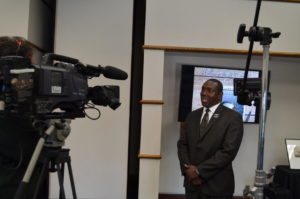Netflix and Hulu and HBO GO, Oh My!
Published on March 29, 2017, at 08:30 a.m.
by Tristen Gell.
Since the rise of online streaming services, the traditional television industry has seen a decline in viewership. According to MarketingCharts, “between 2011 and 2016, Q3 traditional TV viewing by 18-24-year-olds dropped by more than 9-and-a-half hours per week, or by roughly 1 hour and 20 minutes per day.”
Traditional TV is not as feasible as it used to be — especially with younger generations. People want to be able to watch their favorite shows on their own time and on whatever device they please.

Jennifer Giddens, senior vice president of marketing and digital for Sprout, NBC Universal Cable Entertainment’s 24 hour kids network, said the role of traditional television has changed due to the variety of options available to the public.
“I think the idea of scheduled traditional TV has evolved,” Giddens explained. “I think consumers’ lives are filled with more options, responsibilities and time challenges, and they desire the ability to be flexible in how and when they consume content.”
So, how can traditional television stay relevant in today’s society?
Gary McCormick, principal owner at GMc Communications and former director of corporate communications at Scripps Networks Interactive, said TV stations need to focus on a local approach in order to stay relevant.
“Local television stations still play a role in helping local businesses to connect to their community,” McCormick said. “The news and public affairs programming, as well as the advertising, provide a direct, accessible way to reach consumers. While many will access an online option for this, many people still want to know where they can find local businesses that have goods they are looking to find. Their hyper-focus on local will continue to grow on air and online for them to succeed.”
A steady decline in an industry typically points to a steady decline in the number of jobs available in it. Specifically, within the public relations industry, if there is not an audience to market and appeal to, what is the use for PR jobs? However, McCormick argues there is an increase in available jobs.
“With the increase of engagement with consumers through social media, there is probably an overall increase in jobs, although they may not be labeled as public relations,” McCormick said. “The overall function is principally the same: promoting shows, talent and tune-in, while also making sure the reputation is protected.”
Giddens also believes there has not been a decline in available roles within the industry.
“I have not seen a decline,” Giddens said. “I think the evolving needs require candidates to evolve and develop and possibly take on more than the roles may have historically required.”
Although there is not an apparent decline in the job market, there is still the pressing matter in the loss of numbers in viewers. TV stations need to look to the public relations department for help. In this industry, it is important for PR teams to adapt to the changing times, and it is important to find a competitive edge.

“Today, with social media, websites for networks and distribution channels like Netflix, Hulu and Sling, the role of public relations focuses more on the program content, the social media connections to audiences and behind-the-scenes and additional information that make the content more compelling,” McCormick said. “It is multi-platform and multi-dimensional in finding ways to engage consumers/viewers.”
PR professionals must find new, innovative ways to bring viewers back. To achieve this goal, Giddens said awareness is key.
“I think it is continually important that brands stay aware of needs and desires of their audience,” Giddens said. “[They should] try to provide quality experiences to match, and do all they can to tell them about that commitment and how to be a part of it.”
Students looking to pursue a career in public relations have the desire to apply to industries on the rise. It’s important to look for roles where the industry is thriving, because there could be potential for one to climb the corporate ladder.
As for the traditional television industry, Giddens said that students should not worry because PR roles will always be available in this industry.
“I think these roles may look different or function differently but communication and information are vital for those making decisions, even if how that looks evolves and changes over time,” Giddens explained.
McCormick agrees with Giddens’ outlook and believes roles will be available as long as consumers are actively seeking out information.
“As long as consumers want to connect with content, talent and find out more about television, there will be a role for public relations,” McCormick said. “I think we will always have television programs with strong story lines, great acting and high production values as part of the entertainment mix that people will want.”
For students looking to work in the traditional television industry long term, an important thing to do is network. The public relations world can be a small one, so networking can help elevate your success in the future. McCormick said networking is key in the television industry.
“Just like every job that I’ve found in my career, it’s a matter of networking and doing your homework,” McCormick said. “It’s who you know and what you know about their product that will get you in the door for the interview and, hopefully, the job.”
Although we are seeing a decline in viewership in the traditional television industry due to online streaming services, traditional TV will more than likely always be around. If traditional TV is still around, that means that public relations roles will always be available within this industry.
“And I believe that good journalism, good television, can make our world a better place.” — Christiane Amanpour.




